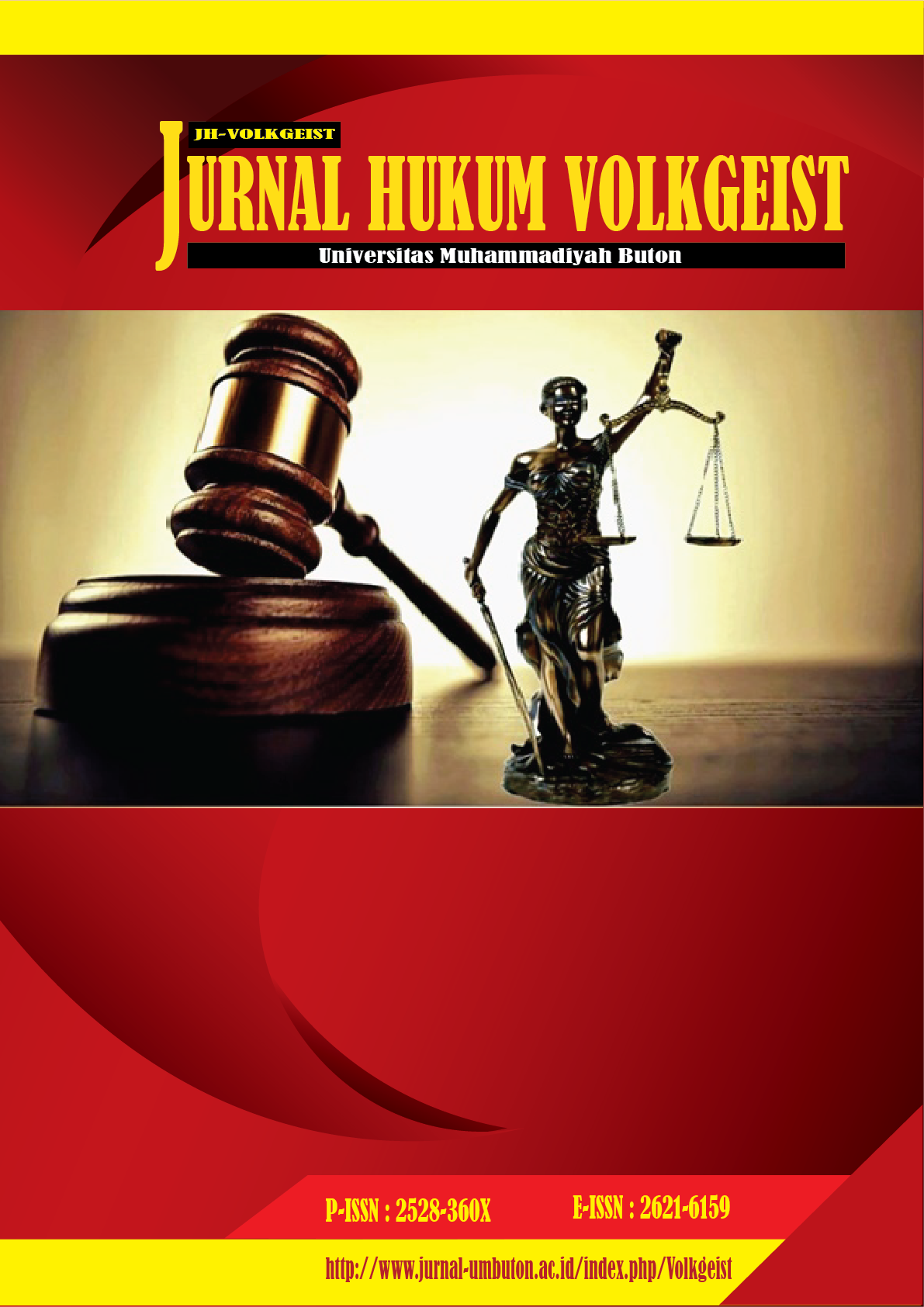Legal Effectiveness of Marriage Age Restrictions in Indonesia
DOI:
https://doi.org/10.35326/volkgeist.v7i1.2490Keywords:
Age Restriction, Child Marriage, Marriage DispensationAbstract
The Marriage Law in Indonesia deals with the base age for marriage in article 7 of Law No. 1 of 1974, for men 19 years and women 16 years, which was overhauled through Law No. 16 of 2019 by raising quite far for women to 19 years, as a work to decrease the speed of youth marriage which is still exceptionally high in Indonesia. The motivation behind this paper is to take a gander at the viability of the marriage age limitation regulation and find the right answer for kid marriage that happens in Indonesia. The outcomes got those the base age limitations for marriage have not been compelling sufficient in diminishing the act of child marriage. The applications for marriage dispensation over the most recent two years in strict courts all through Indonesia that showed a high expansion in applications contrasted with the years prior to the change of article 7 of the marriage regulation. In addition, albeit the marriage regulation exists as a crisis response, there actually should be a base age limit in the application for the marriage agreement, with the goal that the age of the candidate underneath the cutoff can be dismissed.
Downloads
References
AIP J2 (Australia Indonesia Partnership for Justice 2). (2019). Analisis Putusan Dispensasi kawin di Indonesia. AIP J2 (Australia Indonesia Partnership for Justice 2). Retrieved from https://aipj.or.id/pages/publication/analisis-putusan-dispensasi-kawin-di-indonesia
Andina, E. (2021). Meningkatnya Angka Perkawinan Anak Saat Pandemi Covid-19. Info Singkat, 13(4). Retrieved from http://sdip.dpr.go.id/search/detail/category/info Singkat/id/1162
Bahasa, B. P. (2016). Kamus Besar Bahasa Indonesia (5th ed.). Jakarta: Kementerian Pendidikan dan Kebudayaan Republik Indonesia.
Effendy, D. (2019). Problematika dan Solusi Pelaksanaan Undang-Undang No. 16 Tahun 2019 Tentang Perkawinan. Retrieved from https://www.pta-pontianak.go.id/berita/artikel/862-problematika-dan-solusi-pelaksanaan-undang-undang-no-16-tahun-2019-tentang-perkawinan
Inayati, I. N. (2015). Perkawinan Anak di Bawah Umur dalam Perspektif Hukum, HAM dan Kesehatan. Jurnal Bidan “Midwife Journal”., 1(1), 46–53.
Kadarisman, A., & Hamidah, T. (2021). Pembatasan Usia Perkawinan dalam Sudut Pandang Maqashid Syari’ah Al Syathibi. Cendekia: Jurnal Studi Keislaman, 7(1), 115–138. Retrieved from https://www.neliti.com/publications/389291/pembatasan-usia-perkawinan-dalam-sudut-pandang-maqashid-syariah-al-syathibi
Muhammad, H. (2007). Fiqh Perempuan Refleksi Kiai atas Wacana Agama dan Gender (3rd ed.; A. Q. Faqihuddin, ed.). Yogyakarta: LKiS.
Muntamah. (2019). Pernikahan Dini di Indonesia; Faktor dan Peran Pemerintah (Perspektif Penegakan dan Perlindungan Hukum Bagi Anak). Jurnal Hukum, 2(1).
Ramadhita. (2014). Diskresi Hakim: Pola Penyelesaian Kasus Dispensasi Perkawinan. De Jure, Jurnal Syariah dan Hukum, 6(1), 59–71. Retrieved from http://ejournal.uin-malang.ac.id/index.php/syariah/article/view/3192
Summer, C. (2020). Policy Paper 19: Mengakhiri Pernikahan Anak di Indonesia: Peran Pengadilan. Melbourne: Centre for Indonesian Law, Islam and Society.
UNICEF, BPS, Bappenas, P. U. (2020). Pencegahan Perkawinan Anak; Percepatan yang Tidak Bisa Ditunda.
Zainuddin, A. (2009). Metode Penelitian Hukum (1st ed.; L. Wulandari, ed.). Jakarta: Sinar Grafika.
Zulfiani. (2017). Kajian Hukum Terhadap Perkawinan Anak di Bawah Umur Menurut Undang-Undang Nomor 1 Tahun 1974. Jurnal Hukum Samudra Keadilan, 12(2), 211–222. Retrieved from https://ejurnalunsam.id/index.php/jhsk/article/view/136
Downloads
Submitted
Accepted
Published
Issue
Section
License
- Author retains the copyright and grants Jurnal Hukum Volkgeist the right of first publication of the work simultaneously licensed under the Creative Commons Attribution-ShareAlike 4.0 License that allows others to share the work with an acknowledgment of the work's authorship and initial publication in this journal
- The author is able to enter into separate, additional contractual arrangements for the non-exclusive distribution of the journal's published version of the work (e.g., post it to an institutional repository or publish it in a book) with the acknowledgment of its initial publication in this journal.
- The author is permitted and encouraged to post his/her work online (e.g., in institutional repositories or on their website) prior to and during the submission process, as it can lead to productive exchanges, as well as earlier and greater citation of the published work (See The Effect of Open Access).









.png)































